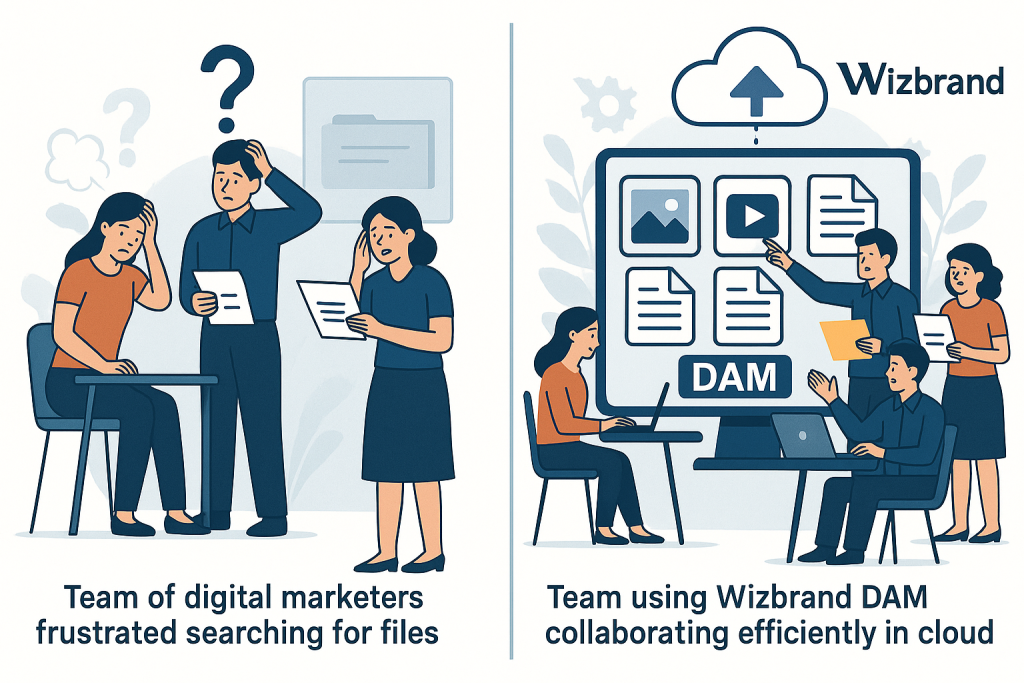
In today’s fast-paced digital world, content is king. Whether you are a digital marketer, part of a content team, or an SEO professional, content is at the heart of your strategy. But managing that content efficiently can be a daunting task, especially as your digital assets multiply. Without a proper system in place to organize, store, and manage these assets, the consequences can be severe. This is where Digital Asset Management (DAM) systems come into play. But what happens when you don’t use a DAM system? In this blog, we’ll uncover the hidden costs of not utilizing a DAM system and how platforms like Wizbrand can help.
What is a DAM System and Why is it Essential?
A Digital Asset Management system (DAM) is a centralized platform that allows teams to store, organize, retrieve, and manage digital assets like images, videos, documents, and other content. It’s a crucial tool that helps teams avoid unnecessary chaos, providing a single source of truth for all your media assets. Without a DAM system, teams can face multiple issues that significantly affect their efficiency and overall productivity.
Hidden Costs of Not Using a DAM System
1. Wasted Time Searching for Assets
One of the most immediate and tangible costs of not having a DAM system is the time wasted searching for assets. Imagine a content team member spending 30 minutes to find the right image or video for a blog post or social media campaign. When these lost moments accumulate, they can result in significant productivity loss over weeks and months. Instead of being able to focus on creative or high-priority tasks, employees are forced to sift through unorganized files, causing delays in content production.
A robust DAM system like Wizbrand organizes your digital assets and makes them easy to find. The system’s intuitive search feature allows users to quickly locate the right files, saving time and enhancing workflow efficiency.
2. Increased Risk of Content Duplication
Without a DAM system, managing digital content can be chaotic, leading to duplicated assets. When teams work in silos without clear guidelines or a central repository, it’s easy to lose track of assets. Multiple versions of the same file get created, causing confusion and clutter. This duplication not only wastes storage space but also makes it difficult to track which version is the most up-to-date, leading to potential errors and inconsistencies in marketing campaigns.
By implementing the right DAM system, you can eliminate the chances of content duplication. With version control and automatic updates, teams can be confident that they are always working with the most current files, reducing the risk of costly mistakes.
3. Inconsistent Branding Across Teams
Inconsistent branding is another hidden cost that can result from not using a DAM system. When teams are unable to easily access approved logos, brand assets, or style guides, they may unintentionally use outdated or incorrect materials. This inconsistency can damage your brand’s image and confuse customers. Whether it’s a social media post, email campaign, or website update, it’s crucial that all team members have access to the right files that adhere to the brand’s guidelines.
Wizbrand ensures that everyone on the team has access to the latest versions of approved assets. By maintaining brand consistency across all content, you help build a stronger, more unified brand identity that resonates with your audience.
4. Poor Collaboration Between Teams
Effective collaboration is essential for a successful content strategy. However, when digital assets are scattered across multiple platforms or hard drives, it becomes challenging for team members to collaborate effectively. This can lead to miscommunication, missed deadlines, and frustration, particularly when different departments or teams are working on the same project.
A DAM system streamlines collaboration by allowing all teams—whether marketing, SEO, or content creation—to access the same set of assets from a central location. Tools like SEO Management Software ensure that your content team, SEO specialists, and marketers can work seamlessly together, improving productivity and creating a cohesive strategy.
5. Compliance and Security Risks
Without a DAM system, there is a higher risk of compliance violations and security issues. Many industries have strict regulations regarding the use of digital assets, including images, videos, and other media. Without proper organization and control, sensitive data may be accessed by unauthorized individuals or misused, resulting in potential legal issues or security breaches.
A DAM system helps mitigate these risks by providing secure, role-based access control. With a tool like Wizbrand, you can ensure that only authorized personnel have access to specific assets, keeping your organization compliant and secure.
6. Missed Opportunities for Reusing Assets
When your digital assets are disorganized or scattered across different folders or systems, it’s easy to forget what content is available for reuse. This leads to missed opportunities to repurpose or recycle valuable assets that can enhance marketing efforts, drive ROI, and reduce costs.
With a DAM system, assets are easily searchable and categorized, making it simple to find and reuse assets for multiple campaigns or projects. By leveraging previously created content, you can save time and resources, and maximize the value of your assets.
Conclusion

The hidden costs of not using a DAM system for your team can add up quickly, impacting your efficiency, brand consistency, and bottom line. From wasted time to security risks, the absence of a centralized digital asset management solution can create significant roadblocks for your team. That’s where platforms like Wizbrand come in. As one of the Best Digital Asset Management Software solutions available, Wizbrand helps streamline workflows, organize assets, and improve collaboration between teams. By investing in a DAM system, you’re setting your team up for success, ensuring that every asset is utilized to its fullest potential.